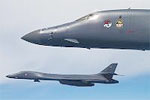B-1 crews are busy while other combat squads lose hours
 The Air Force has forced combat squadrons to stay on the ground and canceled large-scale exercises for its fleet, but one aircraft has been busy in the middle of it all: the B-1B Lancer.
The Air Force has forced combat squadrons to stay on the ground and canceled large-scale exercises for its fleet, but one aircraft has been busy in the middle of it all: the B-1B Lancer.
After canceling a Red Flag this spring and standing down 17 combat-coded squadrons due to mandatory budget cuts, B-1 crews have participated in a Green Flag exercise in May, the 9th Bomb Squadron flew a total of 58 sorties during a surge operation in June, and the service has kept the B-1 on its front pages with news releases about its endeavors and importance.
The activity is not so much about preparing the bombers for future missions, especially with talks about U.S. support in Syria, but more about the effects of grounding a fleet as small as the B-1, said Rebecca Grant, president of the IRIS Independent Research think tank in Washington.
“[The Air Force is] combining funding streams to squeeze a few more hours out of the B-1 fleet so it doesn’t end up as devastated as it would otherwise,” she said.
Most of the squadrons forced to stand down in April were fighters. The service has 249 F-15 C/Ds and 1,018 F-16 C/Ds but only 66 active B-1s. So by cutting back on flying hours, the Air Force could possibly do irreparable harm to its Lancers and aircrews, Grant said.
Additionally, unlike the nuclear-capable B-2s and B-52s, the B-1 is exclusively handled by Air Combat Command and deals with separate funding issues than the strategic bombers under Global Strike Command, Grant said.
The Green Flag-West exercise was held May 17-31 at Nellis Air Force Base, Nev. Crews from the 9th Bomb Squadron at Dyess Air Force Base, Texas, focused on close air support training in a constrained environment.
“This was the first year that we trained in a CDOL constrained environment while at Green Flag,” 9th Bomb Squadron Capt. Christopher Pace told Armed Forces News Service at the exercise. “It’s not something we typically do, but because Afghanistan is drawing down and our focus is shifting to the Pacific, being able to operate in these types of environments is becoming an increasingly crucial skill set to have for future conflicts.”
The same squadron flew 58 sorties over four days in early June at Dyess to let pilots and maintainers work like they would if they were deployed.
“The typical process for a flyer would be to come in and plan for six hours, brief and then fly the next day,” said Maj. Mike Taylor, 9th BS chief of weapons and tactics, in a release. “But to fly the amount of sorties we needed for the surge, the mission planning was done before we arrived, allowing us time to come in, get what we need and fly, all within about two hours.”
After Air Combat Command’s April announcement that combat squadrons would be grounded, the command on May 1 found funding to return a B-1 squadron to fully mission-capable at Ellsworth Air Force Base, S.D.
But with the good news comes other bad news for B-1 squadrons. The 77th Weapons School at Dyess has seen its pilots lose currency because the school’s budget had been cut in half due to sequestration. Pilots can’t fly for yearly proficiency requirements, meaning they can’t fly as instructors for other pilots.
“Based on the last time each of our instructors flew, their currencies will last them through the middle of July,” said Lt. Col. Jonathan Creer, 77th WPS commander, in a release. “Bottom line is we won’t be able to fly.”